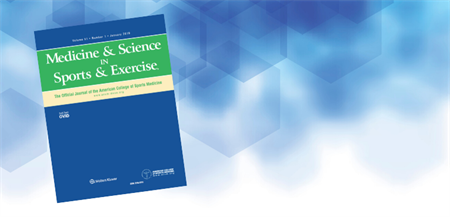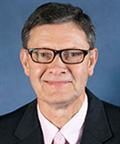L. Bruce Gladden, Ph.D., FACSM |
Feb.
8, 2021
In 2020, Medicine & Science in Sports & Exercise® (MSSE®) published 304 articles, amounting to 2,690 pages of text. These articles were published out of approximately 1,300 submissions at an acceptance rate of 24.6%. As expected of the American College of Sports Medicine’s (ACSM) flagship journal, the scientific content of these articles was broad-based and representative of the varied interests of ACSM’s membership.
 One measure of interest in published articles is the number of times the online version of each paper is viewed. This online content can be viewed either through an institutional subscription to the journal (Ovid) or through the journal website itself. Viewing frequency often varies between these two platforms. I have combined the Ovid and journal website views to develop our top 10 viewed papers of those published in 2020 (disregarding published online ahead of print). Five of the top 10 viewed articles related to resistance/strength training. The most highly viewed article enlisted 19 participants in unilateral leg strength training for 10 weeks followed by 20 weeks of detraining. After the detraining period, the participants performed one resistance exercise session with both legs. Several key regulatory genes and proteins involved in muscular adaptations to resistance exercise gave positive responses in the previously trained leg as compared to the leg that had not been previously trained. These results provide a mechanistic basis for a molecular “muscle memory” in response to training. Two of the resistance training papers related to cancer, indicating the further entry of exercise training considerations into cancer treatment and the overall well-being of cancer patients (in breast cancer patients and in prostate cancer patients). Another of the most viewed papers reported the physiological profile of a 59-year-old world record holder marathoner. Amazingly, this aging athlete had a V̇O2max of 65.4 ml·kg-1·min-1 and ran his marathon pace at 91% of his V̇O2max!
One measure of interest in published articles is the number of times the online version of each paper is viewed. This online content can be viewed either through an institutional subscription to the journal (Ovid) or through the journal website itself. Viewing frequency often varies between these two platforms. I have combined the Ovid and journal website views to develop our top 10 viewed papers of those published in 2020 (disregarding published online ahead of print). Five of the top 10 viewed articles related to resistance/strength training. The most highly viewed article enlisted 19 participants in unilateral leg strength training for 10 weeks followed by 20 weeks of detraining. After the detraining period, the participants performed one resistance exercise session with both legs. Several key regulatory genes and proteins involved in muscular adaptations to resistance exercise gave positive responses in the previously trained leg as compared to the leg that had not been previously trained. These results provide a mechanistic basis for a molecular “muscle memory” in response to training. Two of the resistance training papers related to cancer, indicating the further entry of exercise training considerations into cancer treatment and the overall well-being of cancer patients (in breast cancer patients and in prostate cancer patients). Another of the most viewed papers reported the physiological profile of a 59-year-old world record holder marathoner. Amazingly, this aging athlete had a V̇O2max of 65.4 ml·kg-1·min-1 and ran his marathon pace at 91% of his V̇O2max!
Social impact of scientific articles is evaluated by the altmetric score, which considers tweets, blogs, Facebook mentions, coverage by news outlets, etc. The most mentions for MSSE® articles appearing in print in 2020 included papers studying the effects of high intensity sprinting. One article investigated the effect of performing high-intensity training prior to playing a video game. The exercise improved video game performance! Another of these socially impactful papers investigated the effects of interrupting prolonged sitting with 4s sprints. Five sets (4s x 5) of these short sprints performed each hour over 8 hours of sitting lowered the next day's postprandial plasma triglyceride response and increased fat oxidation after a high-fat meal in healthy young adults. This latter article was accepted last April and appeared in print in October.
Regardless of article access and reading and social media mentions, the ultimate scientific impact of research shows up in citations in the scientific literature. To capture this aspect of the journal, my last list below shows the top ten most cited articles that appeared in print in MSSE® in 2019. Of special note is the fact that seven of the 10 most-cited papers from 2019 are from the series of 14 articles relating reviews by the Physical Activity Guidelines Advisory Committee in the June 2019 issue of MSSE®; I highlighted these articles in last year’s blog about the top articles of 2019. As a reminder, Dr. William Kraus, Immediate Past-President of ACSM, spearheaded submission of that group of papers. Additionally, a contrasting perspectives piece was published last year as well. This one debated whether or not hypoxic training is beneficial in elite athletes with Grégoire Millet and Franck Brocherie taking the pro side versus Christoph Siebenmann and Jerry Dempsey on the con side. It will be interesting to see the citation records of the most viewed and talked about (altmetric rating) articles of 2020 by the end of this year.
Most Viewed Articles of 2020 (Ovid and MSSE website combined)
- Exercise Induces Different Molecular Responses in Trained and Untrained Human Muscle
- Contralateral Effects by Unilateral Eccentric versus Concentric Resistance Training
- Low-Frequency HIIT Improves Body Composition and Aerobic Capacity in Overweight Men
- Velocity Loss as a Critical Variable Determining the Adaptations to Strength Training
- Physical Activity and Academic Performance: Genetic and Environmental Associations
- Physiological Profile of a 59-Year-Old Male World Record Holder Marathoner
- Casein Ingestion Does Not Increase Muscle Connective Tissue Protein Synthesis Rates
- Exercise Training Reduces Reward for High-Fat Food in Adults with Overweight/Obesity
- Reporting of Resistance Training Dose, Adherence, and Tolerance in Exercise Oncology
- Heavy Resistance Training in Breast Cancer Patients Undergoing Adjuvant Therapy
Articles Appearing in Print in 2020 with Highest Altmetric Score
- Exercise Improves Video Game Performance: A Win-Win Situation
- Hourly 4-s Sprints Prevent Impairment of Postprandial Fat Metabolism from Inactivity
- Leucine Supplementation Has No Further Effect on Training-induced Muscle Adaptations
- Velocity Loss as a Critical Variable Determining the Adaptations to Strength Training
- Exercise Induces Different Molecular Responses in Trained and Untrained Human Muscle
- Temporal Muscle-specific Disuse Atrophy during One Week of Leg Immobilization
- Power of Words: Influence of Preexercise Information on Hypoalgesia after Exercise-Randomized Controlled Trial
- Timing of Vaccination after Training: Immune Response and Side Effects in Athletes
- "Chemotherapy-periodized" Exercise to Accommodate for Cyclical Variation in Fatigue
- Exercise for Weight Loss: Further Evaluating Energy Compensation with Exercise
 L. Bruce Gladden, Ph.D., FACSM, Editor-in-Chief of Medicine & Science in Sports & Exercise®, is a professor in Auburn University’s School of Kinesiology. His work is focused on bioenergetics, and the role of lactate in skeletal muscle and whole-body metabolism. He is the author or co-author of more than 110 refereed research articles and reviews, and his investigative work has attracted research funding from the National Institutes of Health, National Science Foundation, NATO and private research foundations. Dr. Gladden has served as president of the southeast chapter of ACSM, a member of the ACSM Board of Trustees and is currently President-Elect of ACSM. He was the recipient of an ACSM Citation Award in 2015 in recognition of his significant contributions to sports medicine and the exercise sciences.
L. Bruce Gladden, Ph.D., FACSM, Editor-in-Chief of Medicine & Science in Sports & Exercise®, is a professor in Auburn University’s School of Kinesiology. His work is focused on bioenergetics, and the role of lactate in skeletal muscle and whole-body metabolism. He is the author or co-author of more than 110 refereed research articles and reviews, and his investigative work has attracted research funding from the National Institutes of Health, National Science Foundation, NATO and private research foundations. Dr. Gladden has served as president of the southeast chapter of ACSM, a member of the ACSM Board of Trustees and is currently President-Elect of ACSM. He was the recipient of an ACSM Citation Award in 2015 in recognition of his significant contributions to sports medicine and the exercise sciences.